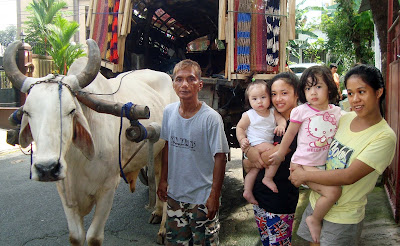About
11 million people worldwide, and about a million in the United States, belong
to an ethnic group known as the Roma or Romani. They are more commonly called
Gypsies or travelers. The Roma people
migrated to Europe from India about 1,500 years ago.
Dr Abe V Rotor
Living with Nature - School on Blog [avrotor.blogspot.com]
Paaralang Bayan sa Himpapawid (People's School-on-Air) with Ms Melly C Tenorio
738 DZRB AM Band, 8 to 9 evening class, Monday to Friday [www.pbs.gov.ph]
Mang Juan poses with his travelling cariton pulled by a bullock, 2015.
Gypsy - that's the medieval term to describe the unique ethnic life of a people, mainly the Romani, and other tribes as well that led a nomadic lifestyle, selling wares, entertaining people and "camping" in their carts along their indefinite route.
They had laws and rules of their own, keeping their unity and preserving their culture, which the outside world barely understood as to regard them integrated into the main stream of society. But they were not, and in fact they were persecuted like the Jews.
If there is such a thing as "wandering Jews" who were deprived of their country and discriminated as Jews, the gypsies too were treated the same. Many of them died under Nazi rule in WW II, and their number was decimated - yet they carried on.
In fact, any lifestyle in any country that is similar in some respects with the life of a gypsy is automatically given a name as such - gypsy, as if it is a universal connotation, although it may be a far cry from the true and original gypsy culture.
Yes, basically the gypsy is nomadic, but the later gypsies built homes and communities of their own, where they enjoyed a sense of belonging and loyalty to their unique culture. Today all over the world they are being integrated into the mainstream of society.
Beliefs that they can foretell the future with crystal balls and tarot cards remain as signature of gypsies, historically their main trade. Costumes speak at a glance the identity a gypsy lady like Esmeralda, the gypsy in Victor Hugo's The Hunchback of Notre Dame.
In the novel, Esmeralda ignited clash beween rich and poor, exposed social ills of medieval France. Her sensual physical attributes became the object of lust, greed and murder. On the other hand, she also gained sympathy and compassion - on behalf of her own people.
There are no true gypsies in the Philippines, and if there is any, they are the like of Mang Juan who earns a living by ambulant selling of native crafts, from broom to hammock, native furniture to kitchen utensils. His trade route is Pangasinan to Manila, a distance of 300 km.
Call it aculturation or cultural integration, globalization in the larger sense. Acceptance from the top and adaptation from below - and aggrupation. How wide the gap exists, is a challenge to society. While this is key to integration, there is equally a potential repercussion, and danger - the loss of diversity which is the biggest threat to mankind in our postmodern times.~
Gypsy families on the move prepared to camp for the night; Gypsy performing art is world renown.Their music, dance and costume are distinctly unique.






No comments:
Post a Comment